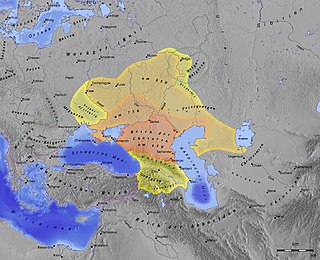 W
WBalgitzin, in the account of Theophanes the Confessor, was the Khazar tudun of Phanagoria during the sojourn of Justinian II in that town. He was dispatched, along with Papatzys, by Busir Khagan to kill Justinian in 704, after Busir was bribed by Tiberius III. Justinian's Khazar wife Theodora warned him in advance and Justinian escaped by sea, but not before murdering both Papatzys and Balgitzin.
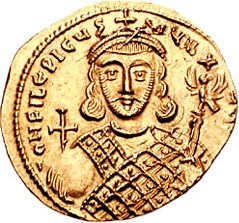 W
WPhilippikos or Philippicus was Emperor of the Byzantine Empire from 711 to 713.
 W
WThe Theme of Cherson, originally and formally called the Klimata was a Byzantine theme located in the southern Crimea, headquartered at Cherson.
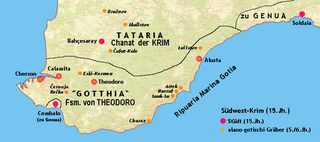 W
WCrimean Goths were Greuthungi-Gothic tribes who remained in the lands around the Black Sea, especially in Crimea. They were the least-impactful on the fate of Europe and the longest-lasting of the Gothic communities. Their existence is well attested through the ages though the exact period when they ceased to exist as a distinct culture is unknown; as with the Goths in general, they may have been diffused with the surrounding peoples. In the Fourth Turkish letter by Ogier Ghiselin de Busbecq, they are described as "a warlike people, who to this day inhabit many villages" though in the 5th century, Theodoric the Great failed to rouse Crimean Goths to support his war in Italy. At the time, it was customary to refer to a wide range of Germanic tribes as "Goths", so the exact ethnic origin of the Germanic peoples in Crimea is a subject of debate.
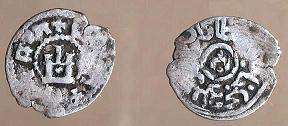 W
WDawlat Berdi, also known as Devlet Berdi, was a Khan of the Golden Horde who reigned from 1419 to 1421, and again from 1428 to his death in 1432. He was the son of Jabbar Berdi and a descendant of Berke Khan.
 W
WMangup also known as Mangup Kale is a historic fortress in Crimea, located on a plateau about 13 kilometres due east of Sevastopol.
 W
WGazaria is the name given to the Genoese colonies in Crimea and around the Black Sea from the mid-13th century to the late 15th century.
 W
WGeorgius Tzul was a Khazar warlord against whom the Byzantine Empire and Mstislav of Tmutarakan launched a joint expedition in 1016.
 W
WJohn of Gothia was a Crimean Gothic metropolitan bishop of Doros, and rebel leader who overthrew and briefly expelled the Khazars from Gothia in 787. He was canonized as an Eastern Orthodox saint.
 W
WJustinian II, surnamed Rhinotmetos or Rhinotmetus, was the last Byzantine Emperor of the Heraclian dynasty, reigning from 685 to 695 and again from 705 to 711. Like his predecessor of the same name, Justinian II was an ambitious and passionate ruler who was keen to restore the Roman Empire to its former glories, but he responded brutally to any opposition to his will and lacked the finesse of his father, Constantine IV. Consequently, he generated enormous opposition to his reign, resulting in his deposition in 695 in a popular uprising, and he only returned to the throne in 705 with the help of a Bulgar and Slav army. His second reign was even more despotic than the first, and it too saw his eventual overthrow in 711, abandoned by his army who turned on him before killing him.
 W
WAbraham Kirimi was a 14th-century Crimean rabbi.
 W
WMaria Asanina Palaiologina, better known as Maria of Mangup or Maria of Doros, was the second wife of Prince Stephen the Great and as such Princess consort of Moldavia from September 1472 to 1475 or 1477. Of uncertain parentage, but most likely a descendant of imperial Bulgarian and Byzantine dynasties, she belonged to the ruling class of the small Crimean Principality of Theodoro. Her close relatives included both warring princes of Theodoro, Alexios II and Isaac, as well as Zuan Tzamplakon, diplomat and leader of Stratioti.
 W
WPapatzys was, in the account of Theophanes the Confessor, the Khazar tudun of Kerch during the sojourn of Byzantine emperor Justinian II in Phanagoria. He was dispatched, along with Balgitzin, by Busir Khagan to kill Justinian in 704, after Busir was bribed by Tiberius III. Justinian's Khazar wife Theodora warned him in advance and Justinian escaped by sea, but not before murdering both Papatzys and Balgitzin.
 W
WPerateia was the overseas territory of the Empire of Trebizond, comprising the Crimean cities of Cherson, Kerch and their hinterlands. The territory was probably administered during Byzantine rule from Trebizond before the Comneni established a separate empire a few weeks before the Crusader sack of Constantinople in 1204.
 W
WThe Republic of Genoa was an independent state and maritime republic from the 11th century to 1797 in Liguria on the northwestern Italian coast, incorporating Corsica from 1347 to 1768, and numerous other territories throughout the Mediterranean and the Black Sea.
 W
WThe Principality of Theodoro, also known as Gothia or the Principality of Theodoro-Mangup, was a Koine Greek language-speaking principality in the south-west of Crimea. It represented one of the final rump states of the Eastern Roman Empire and the last territorial vestige of the Crimean Goths until its conquest by the Ottoman Empire by the Ottoman Albanian Ghedik Pasha in 1475. Its capital was Doros, also sometimes called Theodoro and now known as Mangup. The state was closely allied with the Empire of Trebizond.
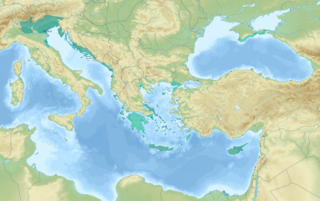 W
WThe Republic of Venice or Venetian Republic, traditionally known as La Serenissima, was a sovereign state and maritime republic in parts of present-day Italy which existed from 697 AD until 1797 AD. Centered on the lagoon communities of the prosperous city of Venice, it incorporated numerous overseas possessions in modern Croatia, Slovenia, Montenegro, Greece, Albania and Cyprus. The republic grew into a trading power during the Middle Ages and strengthened this position in the Renaissance. Citizens spoke the still-surviving Venetian language, although publishing in (Florentine) Italian became the norm during the Renaissance.